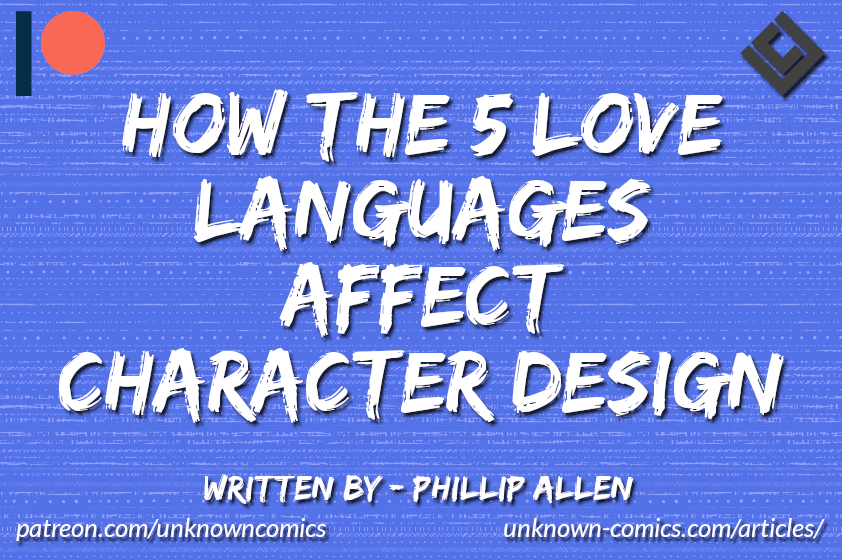There is one thing that drives many characters in our beloved comics to take on the call to action, fall to despair, or give them that extra push to save the day; and that is love. That is why in this article we will be covering how the 5 love languages affect character design. You will also find a case for why this particular aspect should make its way onto your comic character’s character bio’s.
I guess a good first place to begin should be explaining what the 5 love languages are before we begin to discuss how they affect character design.
What Are The 5 Love Languages?
Published back in 1992, Gary Chapman’s The Five Love Languages: How to Express Heartfelt Commitment to Your Mate outlined how everyone has a way that they like to express and feel their love for and toward a romantic partner. As the title goes on to say, there are 5 love languages that people can, and possibly should be aware of, can use.
These love languages are the following: receiving gifts, quality time, words of affirmation, acts of service, and physical touch.
Receiving Gifts
When a comic character has the love language of receiving gifts it means that they feel the most loved when they are receiving gifts. This is not to say that the amount of love they feel from another comes entirely from how costly the gift is, it just means that when they receive a gift they feel that another has shown them an act of affection. These gifts can be anything from flowers, candy, jewelry, a box of deck screws (i.e. something the comic character mentioned they needed), etc.
When a comic character with this love language receives gifts they feel like the gift giver has spent time thinking about them even when they were not together.
Quality Time
The quality time love language is felt by your comic characters that feel the most loved when another individual spends the most time with them. Whether it is with mundane activities like going grocery shopping, making dinner together, watching tv, going on car rides or for a walk for the sake of going out together, etc. As long as another character is spending time with the one with this love language, they will feel loved.
Words of Affirmation
If a character feels the most loved when they are paid compliments or given verbal assurances of their value then they are someone with the love language of words of affirmation. This type of love language is statistically most attributed to women, but even male characters can feel loved when they are given verbal encouragement.
Acts of Service
Acts of services is a language that depends on another character going out of their way to help the character with this love language with some sort of favor, chore, or activity. This can include anything like cooking dinner for someone, taking out the trash, tidying up a room, etc. A request does not need to be made for another character to perform these little acts of service for your character to feel loved.
Physical Touch
Finally, the last of the 5 love languages that can affect character design is physical touch. This love language belongs to the comic characters in your story that feel the most loved when they are physically close or in contact with another. This contact does not need to be sexual in nature. This can include cuddling, hugging, a kiss on the cheek, a pat in the head, etc.
Why Should The 5 Love Languages Be In Your Character Bio?
So now we come to the main point of the article. Why should you even bother taking into consideration which of the 5 love languages your comic character has?
I have spent quite a bit of time thinking about this since I first came across this concept. I believe that besides understanding what sort of behavior your characters respond the best to in respects to their love interests; as a comic character creator you could:
- You can first tell just character prefer to show affection.
- Identify how their loved ones or love interests show their love and when they feel the most loved.
- You can also write down how a character reacts when they encounter other love languages.
What Should You Know About Your Character’s Love Language?
How Characters Show Affection
As important as it is to know when your characters feel the most loves, how about knowing how they prefer to show their affection towards others? Each character can have similar sets, have more than one they enjoy, but to keep things interesting maybe shake things up a bit.
Like the article so far? Support the production of more articles like this one!
How Do Your Comic Characters Feel When Encountering Other Love Languages?
Knowing how your comic character’s love interests or secondary characters show their love or how they feel when they encounter a character that likes to express their romantic interests with a different love language than they respond well with?
Having this detail written down can make it clear when two characters will be easily compatible with each other. Additionally, this can also help distinguish behavior between two or more characters.
Find out whether your character feels positively, negatively, or neutrally when someone pays them compliments, wants to spend a lot of time with them, wants to take care of everything for them, buys them too many gifts, or when someone is always trying to touch them.
What Happens When Two Characters Do Not Share Compatible Love Languages?
When two characters that you may want to appear like potential love interests or already in a relationship do not share compatible love languages it means one thing; struggle.
When two characters do not share compatible love languages one, or both members of the relationship in question may feel unloved, while the other is unaware of how that could be possible even when they are, in their own way, showing them plenty of love.
In my opinion, when we have two characters with an initial incompatibility of love languages, two things can occur; a complete break, or an evolution.
Complete Break Scenario
In this scenario, both parties end up breaking up. The extent of the damage of this break can depend on the scenario you’ve put together. This scenario adds a dramatic conclusion to a relationship you’ve designed.
Evolution Scenario
Another way that you can add struggle to a story with two characters romantically involved with incompatible love languages is to consider character growth. What I mean by this is that one or both characters involved would have to undergo a change to their character, altering their behavior, feelings, and minds towards certain gestures that best make their respective partners feel the most loved.
This scenario can add different types of challenges to their story, building up their character or showing their faults in their unwillingness to change. This can lead to your comic’s characters either changing, which would require an update to their character bio, or entering the complete break scenario after a bit of a delay.
Conclusion
After everything has been said, the question of how the 5 love languages affect the character design of your comic’s cast is, without a doubt, significant.
Not only can you identify just how your characters will react to other people’s attempts to display their affection and interest in becoming romantically involved, but you can identify how they and others will display their affection.
With this information, you can also identify how your comic characters will respond to the other love languages, or when they are in a situation when they have become romantically involved with an individual that they are incompatible with based on their loved language.
No matter what, now you will be able to clearly distinguish between your comic character’s behavior with how they respond to the 5 love languages and how it affects their character design.
Sign Up For
The Unknown Times!
Content Updates
Website News
Recommended Reading
And More to Come!
*Once every two weeks!*
Liked the article? Become part of my Patreon Community!
About The Author

Phillip Allen
Writer, Editor, and Founder of Unknown Comics
Hello there! My name is Phillip Allen and I'm the writer, editor, and founder of Unknown Comics. I am an aspiring comic book creator. In an attempt to learn how to create my own comic I came to learn just how few reliable resources existed out there. From a few books and unhelpful websites I decided to focus my attention on researching and writing a resource for both myself and the rest of the comic creating industry. This website and and its content is the result of all of that hard work.

